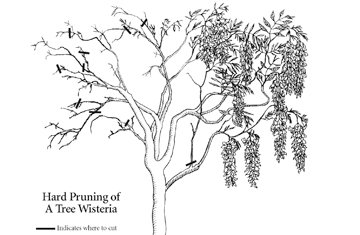






Pronunciation: wis-teer'ee-uh
The spectacular beauty and astonishing vigor of Wisteria are best employed by growing it in the form of a small tree, properly known as a standard. Long racemes of fragrant May flowers drape down from soft green heads of foliage shaped by pruning, and shift gently with every breeze. The effect is graceful and stately, and the compact head of a Tree Wisteria looks sensational in a mixed border of perennials, bulbs, and annuals.
Choosing a Site: Wisterias flower best and grow most vigorously where they receive ample sunshine - at least 6 hours a day. They thrive in any type of soil, as long as it is well drained.
Planting: Remove the packaging around your bareroot Wisteria and soak the roots in a pail of water for a few hours. Then dig a hole wide enough to accommodate the spread of the roots and deep enough to allow you to set the crown (the point where the stem meets the roots) 1in below the surface of the soil. Place the roots in the planting hole and arrange them like the spokes of a wheel or in whatever fashion appears natural. Take extra care when arranging the roots in the planting hole not to break them; the roots of many woody plants are brittle. Holding the crown 1in below the surface of the soil with one hand, push soil into the hole with the other, working soil around the roots to prevent the formation of air pockets. Then firm the soil around the crown, pressing down with both hands. Make a rim of soil around the edge of the planting hole to form a basin. This basin serves to catch and hold water and channel it to the roots. Finally, give the plant a thorough soaking.
Please note: Bareroot plants dry out quickly once they are removed from their packaging - especially on a sunny, breezy day. We strongly recommend that you keep the roots covered with packaging material until you are ready to plant.
Staking: Tree Wisterias need extra support to hold their heads up in strong winds. After planting, push the wooden stake provided with your tree into the ground 6-12in deep and 1/2in away from the plant's trunk. Secure the trunk to the stake at several points about 8in apart, using the plastic tie tape provided with your tree. As the head grows and the trunk expands, you'll need to replace the original stake with a larger wooden stake or a heavy steel pipe. Check the tree in spring and fall to make sure the stake is holding firm and the tie tape used to secure the trunk to the stake is not too tight and restricting expansion of the trunk. Plants should always remain securely staked.
Watering and Fertilizing: The first year after planting, Wisterias need the equivalent of 1in of water per week to speed their establishment. If sufficient moisture fails to fall from the sky, water deeply once a week. Established plants need watering only during prolonged dry spells. Wisterias require little if any fertilizing; excessive fertilizer inhibits bloom. If your soil is especially poor or sandy, you might give plants a light feeding of 5-10-10 or 5-10-5 at the rate of 3/4 cup per square yard in early spring each year.
Overwintering: In cold-winter climates such as ours here in Litchfield (Zone 5 [-20°F]), protect the main stem for the first few winters after planting with a piece of plastic tubing. Make a straight cut from one end to the other and pry the cut open to enclose the stem. (Your local garden center may sell precut tubing.) On older specimens, tie the branches together with twine, cat's-cradle fashion (creating a web of crisscrossing strings), to prevent wind and ice from breaking branches.
Pruning: To preserve the globe shape of the head, tree Wisterias require light but frequent pruning of the long twining branches produced in summer. They also need one hard pruning in late summer or early fall - a few weeks before your first frost date. Cut the current season's growth back to just 5 to 6 large buds (leaving stubs about 6 inches long) and remove poorly placed branches entirely. This severe haircut controls growth and encourages some of the leaf buds to change into flower buds. Don't lose sleep over pruning mistakes. Wisterias are very forgiving; vigorous growth the next season will give you a second chance.
Copyright © www.100flowers.win Botanic Garden All Rights Reserved